CHRO Trends 2023 Report
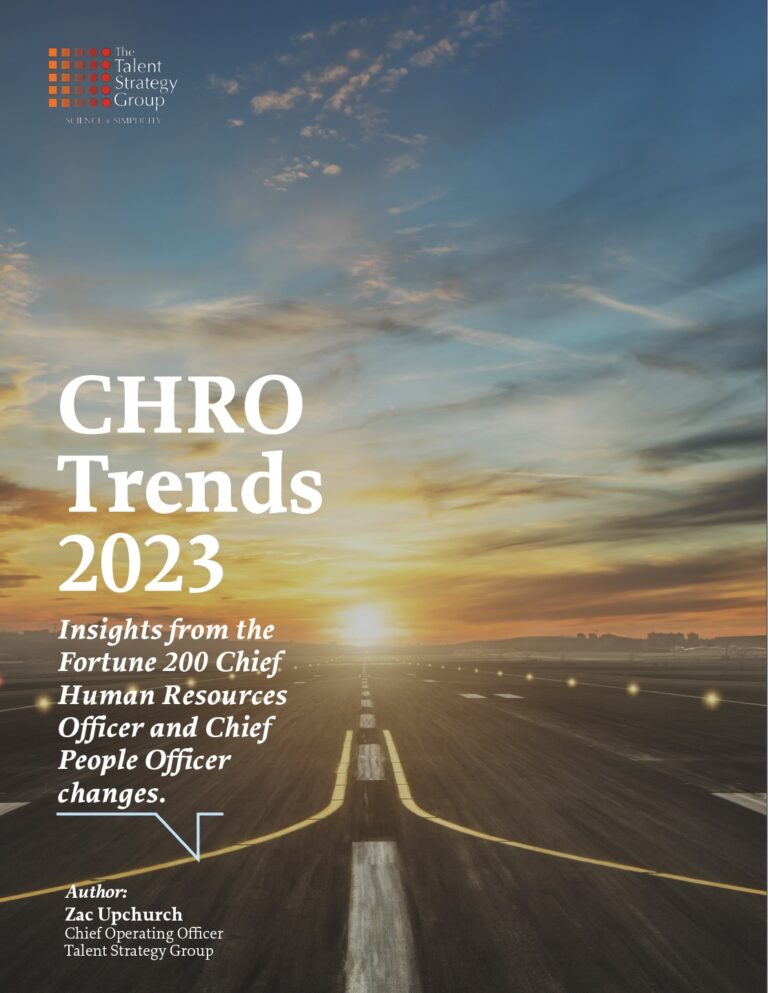
Post content
By Zac Upchurch, Chief Operating Officer, Talent Strategy Group
I am pleased to present our sixth addition of this Chief Human Resources Officer report that outlines the top ten trends in the Fortune 200 company Chief Human Resources Officer (CHRO) and Chief People Officer (CPO) role. In addition, the report introduces the new Fortune 200 CHROs/CPOs that came into the role in 2022.
The Fortune 200 welcomed 28 new CHROs/CPOs, in 2022, implying a 14.7% annual turnover rate for the top Human Resources role. In total, these 28 new CHROs/CPOs manage the human capital of more than 3 million employees and 2022 combined revenues of $1.65 trillion.
The Fortune 200 CHROs/CPOs yields 10 trends, including:
• CEO transitions increase CHRO/CPO turnover by over 2x. 33% of newly appointed Chief Executive Officers turn over their CHRO/CPO within 12 months and 54% within 24 months.
• The Reemergence of Internal CHRO/CPO Successors. Year-on-year, internal succession for the CHRO/SPO has declined, culminating in last year’s report where a minority (41%) of CHRO/CPO appointments were via internal succession. 2022 saw a reversal of this trend as the internal CHRO/CPO successor bounces back with 57% of the 2022 Fortune 200 CHRO/CPO appointments occurring via internal promotions.
• The Chief Human Resources Officer Title Prevails. Chief Human Resources Officer is most prevalent title for the top HR role, representing 43% of the total titles. This is followed by Chief People Officer at 25% and the more generic Human Resources title (e.g., EVP, Human Resources) also at 25%.
I wish to thank the report contributors and I look forward to working with the existing and new Chief Human Resources Officers and Chief People Officers to advance the field of Human Resources in 2023 and beyond.
Trend #1: Female CHROs Maintain Their Dominance
One significant trend in the Chief Human Resources Officer (CHRO) and Chief People Officer (CPO) role is the dominance of female representation in the top Human Resources position. To illustrate, in this report’s 2017 version, 57% of the Fortune 200 CHROs/CPOs were female as compared to 43% male. By the end of 2022, 68% of Fortune 200 CHROs/CPOs are female and 32% male.
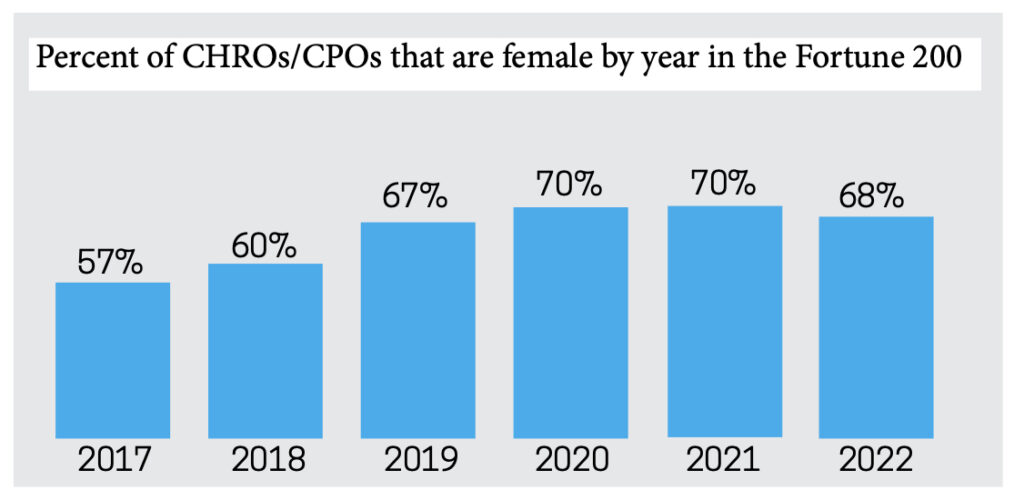
This trend continues through 2022 with 71% of the 28 newly appointed Fortune 200 CHROs/CPOs being female and 29% male. Outgoing female CHROs are replaced by female CHROs/CPOs 82% of the time, while outgoing male CHROs are replaced by female CHROs/CPOs 80% of the time.
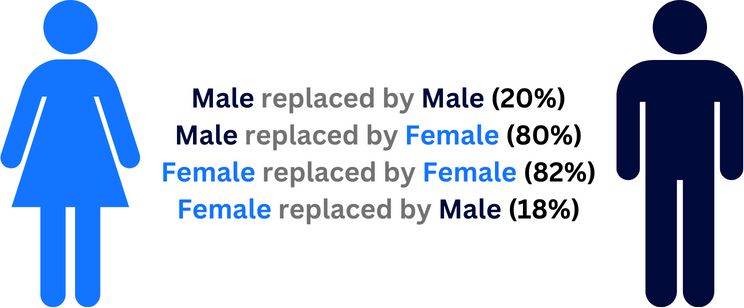
Trend #2: CEO Transitions Increase CHRO/CPO Turnover
A change in leadership for the Chief Executive Officer (CEO) role increases the probability of CHRO/CPO turnover by over 2x (224%). Within 12 months of a CEO transition, 33% of the newly appointed CEOs turn over their CHRO, as compared to the 2022 14.7% turnover rate. Within 24 months of a CEO transition, this probability of CHRO/CPO turnover jumps to a 54% replacement rate or a 183% higher turnover rate relative to the 2022 average.

Trend Three: The Reemergence of Internal CHRO/CPO Successors
A troubling trend emerged across our previous five CHRO Trends reports: There has been a pronounced decline in internal succession for Chief Human Resources Officers and Chief People Officers in favor of externally hired CHROs/CPOs. For example, the inaugural 2017 report found that the majority (70%) of appointed CHROs/CPOs were internal hires. However, year-on-year, internal succession has declined, culminating in last year’s report where a minority (41%) of CHRO/CPO appointments were via internal succession.
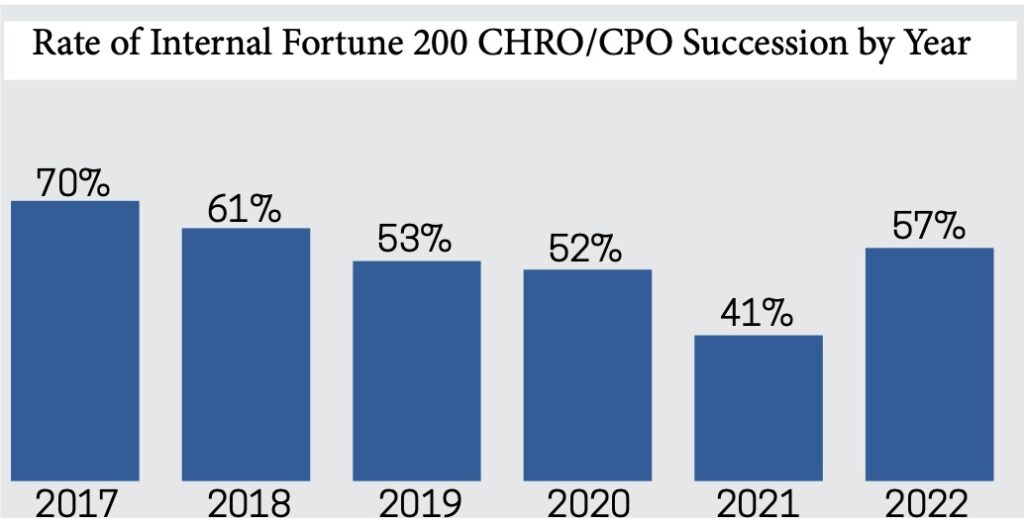
2022 saw a reversal of this trend as the internal CHRO/CPO successor bounces back. 57% of the 2022 Fortune 200 CHRO/CPO appointments were via internal promotions compared to 43% via external hiring.
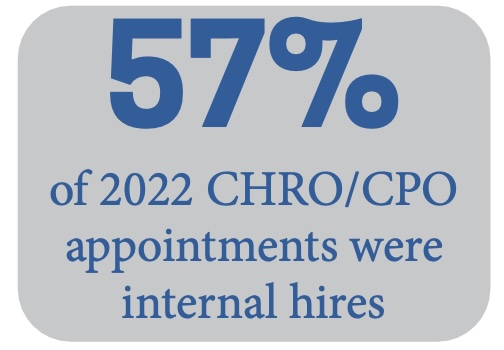
When hiring a CHRO/CPO from the outside, the successful candidate is over 6x more likely to have served as a CHRO/CPO previously as compared to an internally hired CHRO/CPO. 75% of externally hired CHROs/CPOs previously served as a CHRO/CPO prior to their appointment as compared to 12% of internally hired CHROs/CPOs having previously served as a CHRO/CPO.
Internal 2022 Fortune 200 CHRO/CPO hires had varied company tenure prior to their appointment with 37.5% possessing 0-9 years of company tenure prior to CHRO/CPO appointment, 37.5% possessing 10-19 years of company tenure prior to appointment, and the remaining 25% possessing 20+ years of company tenure prior to appointment. This is broadly consistent with the overall Fortune 200 CHROs/CPOs where the average company tenure prior to internal CHRO/CPO appointment was 14.23 years.
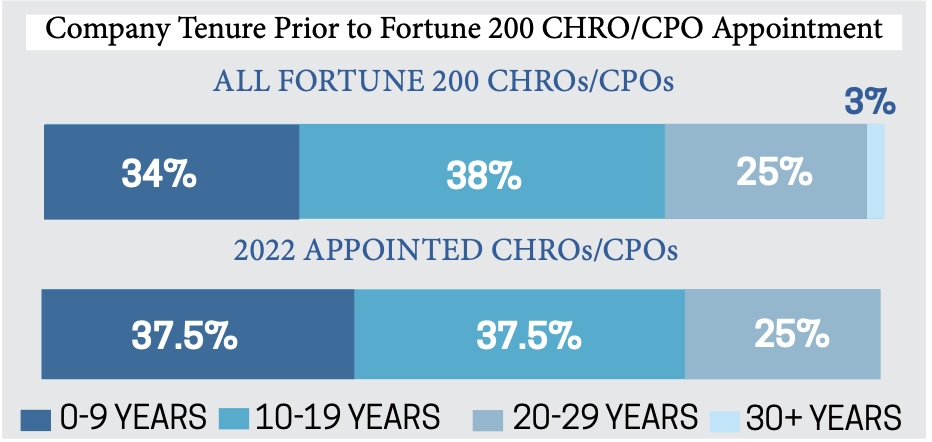
Trend Four: The CHRO and CPO Merry-Go-Round
Two in five (38%) Fortune 200 Chief Human Resources Officers and Chief People Officers previously served as a CHRO/CPO prior to their current CHRO/CPO role. This trend continued for the 2022 appointed CHROs/CPOs where 39% had previously served as a Chief Human Resources Officer or Chief People Officer prior to appointment in their existing role.

This trend of CHRO/CPO appointments presents both advantages and challenges to those in the HR profession. Advantageously, the CHRO/CPO role is held by a larger number of experienced leaders in the top Human Resources position, which can lead to more effective business and people outcomes. However, the downside of this trend is that the rotation of CHROs/CPOs can limit the opportunities for the next generation of HR leaders to move into the top HR seat.
In conversations with high potential HR leaders that aspire to the CHRO/CPO role, this reluctance to take a bet on a first-time CHRO/CPO is often attributed to inadequate investment in HR development and insufficient exposure of HR leaders to critical people functions (e.g., boards, executive compensation, talent management, senior leadership), hindering the efficient and effective build of future HR leaders.
Trend Five: The Path to CHRO/CPO Runs Through the HR Business Partner Role
The path to the CHRO/CPO position continues to predominantly run through the Human Resources Business Partner role (when having not previously served as a CHRO/CPO per trend four, above). Among the 2022 appointed CHROs/CPOs within the Fortune 200, 41% had held the position of HR Business Partner before stepping into the CHRO/CPO role. Notably, 29% of those appointed to the CHRO/CPO role in 2022 had formerly been in roles outside the Human Resources domain, with the legal field being the most prevalent domain. In 2022, Talent Management emerged as the third most prevalent path to ascension for first-time CHROs/CPOs, representing 26% of first-time appointments.

When selecting a CHRO/CPO from outside the Human Resources domain, 100% of the 2022 appointed Fortune 200 CHROs/CPOs had no prior HR domain expertise prior to their appointment.
Trend Six: HR Experience Prevails
Depth of experience in Human Resources is a critical determinant in ascending to the top Human Resources role. 87% of Chief Human Resources Officers and Chief People Officers within the Fortune 200 had prior HR experience before assuming the top HR role. However, in 2022 there was a decline in HR experience for the CHRO/CPO role where a still significant 82% of 2022 newly appointed Fortune 200 CHROs/CPOs had a background in HR prior to their appointment.

When comparing internal/external hiring of CHROs/CPOs to depth of HR experience, the significance of HR experience is even greater. 100% of externally hired CHROs/CPOs had prior HR experience before taking the CHRO/CPO role. This contrasts with internal hires where 23% of the Fortune 200 CHROs/CPOs held no HR experience prior to their ascension.
This data illustrates that depth of Human Resources experience is a vital input to selection for the CHRO/CPO role, especially in external hiring. However, an organization may be willing to sacrifice depth of HR experience for depth of company experience when promoting from within the company.
Trend Seven: Experience Outside of HR is Not Required
The majority (60%) of Fortune 200 CHROs/CPOs spent their entire career in the Human Resources domain, including the 2022 newly appointed Fortune 200 CHROs/CPOs where 58% also spent their entire career in Human Resources. This implies that experience outside of the HR domain isn’t viewed as a requirement in ascending to the top HR role.

Experience outside of HR is more pronounced in internally promoted CHROs/CPOs as compared to externally hired CHROs/CPOs. 47% of the Fortune 200 internally hired CHROs/CPOs held a role in the business, compared to 32% of externally hired CHROs/CPOs. The 2022 newly appointed Fortune 200 CHROs/CPOs illustrates an even greater divide in prior business experience where 75% of the externally hired CHROs/CPOs had spent their entire career in HR as compared to 44% of internally hired CHROs/CPOs.
Trend Eight: CHROs/CPOs are Highly Educated
The Fortune 200 Chief Human Resources Officers and Chief People Officers are highly educated with 99% holding at least a bachelor’s degree or equivalent. In addition, 68% of the Fortune 200 CHROs/CPOs additionally possess an advanced degree. This statistic is unchanged for the 2022 newly appointed Fortune 200 CHROs/CPOs where 68% also hold an advanced degree. The MBA is the most popular advanced degree, followed by a Human Resources-related masters or Ph.D., followed by J.D.
2022 examples include:
- Erin McSweeney joined UnitedHealth Group (Fortune 5) as Executive Vice President and Chief People Officer in March 2022, having previously served as Chief of Staff to UnitedHealth Group’s Chief Executive Officer (and prior to UnitedHealth Group, EVP, HR for EMC). Erin holds a BS, Business, MBA, and J.D.
- Felicia Pryor joined Deere (Fortune 84) as Senior Vice President and Chief People Officer in August 2022, having previously served as EVP and CHRO at BorgWarner. Felicia holds a Bachelors in Criminal Justice, Masters in Public Administration, and a J.D.
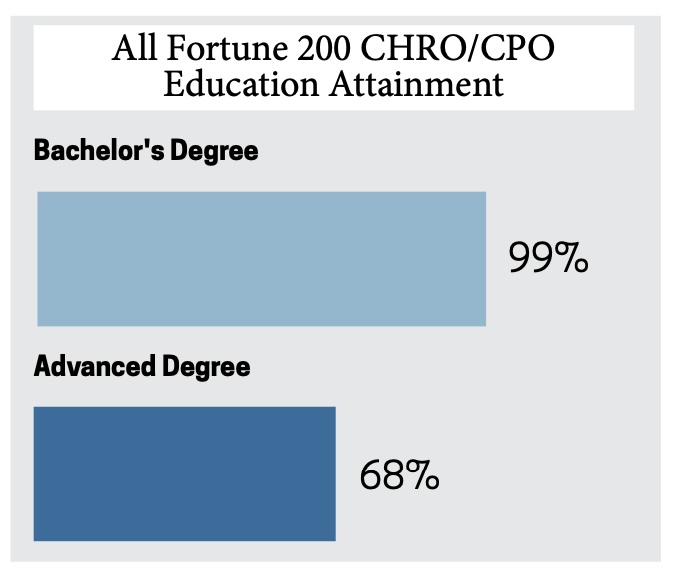
Trend Nine: Chief Human Resources Officer vs. Chief People Officer
Those that have read this report since its inception will notice a transition from the exclusive use of the title Chief Human Resources Officer to describe the top Human Resources role to the split titling scheme of Chief Human Resources Officer and Chief People Officer. This change was the product of feedback from leading CHROs/CPOs that indicated an earnestness in transitioning away from “human resources” terminology to “people-centric” terminology.
In this 2023 report, the team investigated the titles of those in the top HR role to identify the current titling preferences. The results indicate that for the newly appointed Fortune 200 CHROs/CPOs, Chief Human Resources Officer is most prevalent representing 43% of the titles. This is followed by Chief People Officer at 25% and the more generic Human Resources title (e.g., EVP, Human Resources) also at 25%. There were deviations from these title structures, examples being Starbucks (Chief Partner Officer) and Tesla (Champion of the People). 11% of the newly appointed Fortune 200 CHROs/CPOs held a dual role, most prominently Chief Administrative Officer.
The most common reported level for the top Human Resources role is Executive Vice President at 53%, followed by Senior Vice President at 37%. In some instances, the top Human Resources role was a Vice President role such as is the case with Rhonda Morris at Chevron (VP, CHRO) and Pamela Masson at Freeport-McMoRan (VP, CHRO).

Trend Ten: CHRO/CPO Start Date
The most popular start month for the newly appointed Fortune 200 CHROs/CPOs was April and March with 21% and 18% of start dates respectively. This is a contrast to the broader Fortune 200 where January remains the most popular start month at 15% of start dates.
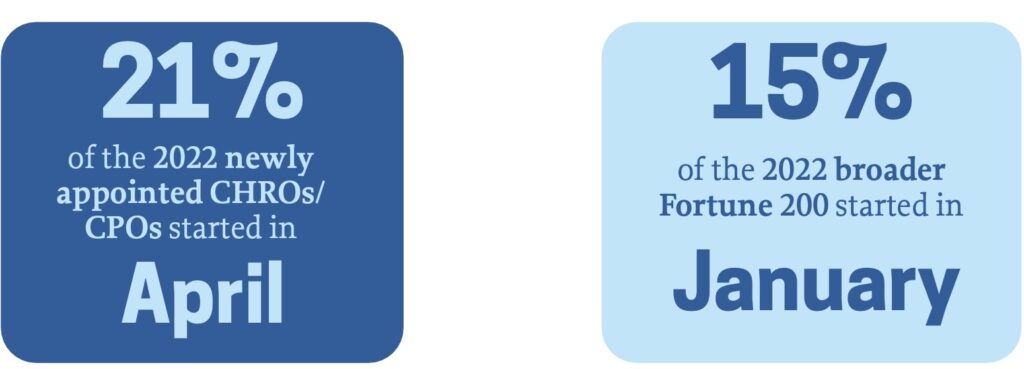
About the Research
This report was produced by analyzing the Fortune 200 companies (based on the 2022 Fortune ranking) and publicly available information for Chief Human Resources Officers and Chief People Officers. We additionally spoke with many CHROs and CPOs and their teams to validate data where publicly available information was not sufficient.
In total, 190 of the Fortune 200 companies had a sitting, identifiable CHRO or CPO at the time of this report writing. The trends highlight those 190 companies. Some companies, for example Berkshire Hathaway, do not have a sitting Chief Human Resources Officer or Chief People Officer. In those situations, the company was excluded from this report’s analysis.
About Zac Upchurch and the Talent Strategy Group
Zac Upchurch leads The Talent Strategy Group, an HR and Talent Management consulting firm. He frequently consults with the Boards and Executive Teams of the world’s most advanced organizations on Human Resources and Talent Management with a focus on the intersection of people and organizations, and enabling the full potential of both. Zac graduated Summa Cum Laude from Arizona State University with a Bachelor’s of Science in Economics. He can be reached at zac@talentstrategygroup.com.
The Talent Strategy Groups helps the world’s highest performing organizations transform Human Resources and their ability to grow talent. Our advisory services include HR strategy, organization design, HR leader assessment, and HR process design. We partner with private equity firms on deal generation, due diligence, and value creation plans from a talent focus. Our education and development services are based at our Talent Management Institute, which is the world’s most popular executive education program on talent. We teach executives and HR leaders how to build better talent, faster through our public and private programs. We advise public and private companies, NGOs, and public sector organizations across geographies and industries. More information is available at www.talentstrategygroup.com.
Please reach out to us with any questions, and we will be more than happy to get back to you!